Variations in Pulsating Aurora Emission in 337 nm and 391 nm Nitrogen Spectral Lines during Geomagnetic Substorms
Abstract
:1. Introduction
2. Instruments and Data Selection
3. Measurements Results
3.1. 11/12 March 2023
3.2. 17/18 March 2023
4. Discussion
- All measurements for both channels during PsAs were divided into “on” and “off” phases. “Off” phases constitute the set of measurements with lower intensities and are considered as a background for the “on” phases. The separation was conducted via a subtraction from a light curve a moving average and a time window equal to 30 s.
- Intensities during “off” phases were interpolated for the periods with pulses to obtain the values of background emissions during “on” phases. In Figure 6, the example of the measured PsA signal and background interpolation is shown for a short but typical case.
- The background intensity values obtained in a previous step were subtracted from measured intensities.
- New values of ratio () were calculated as a ratio of two signals during “on” phases with a subtracted background. The example of the obtained is shown in the bottom panel of Figure 6. It is well seen that average ratio is around three. There are some peaks at the edges of “on” phases—it is an artifact of the described procedure, and these points are eliminated from further analyses. It is interesting to note, rather, large variations in the ratio, which reaches values of about eight.
5. Conclusions
Author Contributions
Funding
Data Availability Statement
Acknowledgments
Conflicts of Interest
Abbreviations
| DUV | Detector of ultraviolet; |
| LOZ | Lovozero; |
| MAPMT | Multianode photomultiplier tube; |
| PAIPS | Pulsating Aurora Imaging Photometers System; |
| REMs | Relativistic electron microbursts; |
| PsA | Pulsating aurora; |
| PMT | Photomultiplier tube; |
| PGI | Polar Geophysical Institute; |
| SAMPEX | Solar Anomalous Magnetospheric Particle Explorer; |
| SINP MSU | Skobeltsyn Institute of Nuclear Physics, Lomonosov Moscow State University; |
| TUS | Tracking Ultraviolet Set-up; |
| UV | Ultraviolet; |
| VTL | Verkhnetulomsky. |
| 1 |
References
- Nishimura, Y.; Lessard, M.R.; Katoh, Y.; Miyoshi, Y.; Grono, E.; Partamies, N.; Sivadas, N.; Hosokawa, K.; Fukizawa, M.; Samara, M.; et al. Diffuse and Pulsating Aurora. Space Sci. Rev. 2020, 216, 4. [Google Scholar] [CrossRef]
- Johnstone, A. Pulsating aurora. Nature 1978, 274, 119–126. [Google Scholar] [CrossRef]
- Hosokawa, K.; Miyoshi, Y.; Ozaki, M.; Oyama, S.I.; Ogawa, Y.; Kurita, S.; Kasahara, Y.; Kasaba, Y.; Yagitani, S.; Matsuda, S.; et al. Multiple time-scale beats in aurora: Precise orchestration via magnetospheric chorus waves. Sci. Rep. 2020, 10, 3380. [Google Scholar] [CrossRef]
- Yamamoto, T. On the temporal fluctuations of pulsating auroral luminosity. J. Geophys. Res. Space Phys. 1988, 93, 897–911. [Google Scholar] [CrossRef]
- Royrvik, O.; Davis, T. Pulsating aurora: Local and global morphology. J. Geophys. Res. 1977, 82, 4720–4740. [Google Scholar] [CrossRef]
- Brown, N.; Davis, T.; Hallinan, T.; Stenbaek-Nielsen, H. Altitude of pulsating aurora determined by a new instrumental technique. Geophys. Res. Lett. 1976, 3, 403–404. [Google Scholar] [CrossRef]
- Miyoshi, Y.; Saito, S.; Kurita, S.; Asamura, K.; Hosokawa, K.; Sakanoi, T.; Mitani, T.; Ogawa, Y.; Oyama, S.; Tsuchiya, F.; et al. Relativistic Electron Microbursts as High-Energy Tail of Pulsating Aurora Electrons. Geophys. Res. Lett. 2020, 47, e90360. [Google Scholar] [CrossRef]
- Miyoshi, Y.; Oyama, S.; Saito, S.; Kurita, S.; Fujiwara, H.; Kataoka, R.; Ebihara, Y.; Kletzing, C.; Reeves, G.; Santolik, O.; et al. Energetic electron precipitation associated with pulsating aurora: EISCAT and Van Allen Probe observations. J. Geophys. Res. (Space Phys.) 2015, 120, 2754–2766. [Google Scholar] [CrossRef]
- Tesema, F.; Partamies, N.; Nesse Tyssøy, H.; McKay, D. Observations of precipitation energies during different types of pulsating aurora. Ann. Geophys. 2020, 38, 1191–1202. [Google Scholar] [CrossRef]
- Kataoka, R.; Miyoshi, Y.; Sakanoi, T.; Yaegashi, A.; Ebihara, Y.; Shiokawa, K. Ground-based multispectral high-speed imaging of flickering aurora. Geophys. Res. Lett. 2011, 38, L14106. [Google Scholar] [CrossRef]
- Shiokawa, K.; Katoh, Y.; Hamaguchi, Y.; Yamamoto, Y.; Adachi, T.; Ozaki, M.; Oyama, S.I.; Nosé, M.; Nagatsuma, T.; Tanaka, Y.; et al. Ground-based instruments of the PWING project to investigate dynamics of the inner magnetosphere at subauroral latitudes as a part of the ERG-ground coordinated observation network. Earth Planets Space 2017, 69, 160. [Google Scholar] [CrossRef]
- Ozaki, M.; Shiokawa, K.; Miyoshi, Y.; Hosokawa, K.; Oyama, S.i.; Yagitani, S.; Kasahara, Y.; Kasaba, Y.; Matsuda, S.; Kataoka, R.; et al. Microscopic observations of pulsating aurora associated with chorus element structures: Coordinated Arase satellite-PWING observations. Geophys. Res. Lett. 2018, 45, 12,125–12,134. [Google Scholar] [CrossRef]
- Klecker, B.; Hovestadt, D.; Scholer, M.; Arbinger, H.; Ertl, M.; Kastele, H.; Kunneth, E.; Laeverenz, P.; Seidenschwang, E.; Blake, J.B.; et al. HILT: A heavy ion large area proportional counter telescope for solar and anomalous cosmic rays. IEEE Trans. Geosci. Remote Sens. 1993, 31, 542–548. [Google Scholar] [CrossRef]
- Blake, J.; Looper, M.; Baker, D.; Nakamura, R.; Klecker, B.; Hovestadt, D. New high temporal and spatial resolution measurements by SAMPEX of the precipitation of relativistic electrons. Adv. Space Res. 1996, 18, 171–186. [Google Scholar] [CrossRef]
- Shumko, M.; Gallardo-Lacourt, B.; Halford, A.J.; Liang, J.; Blum, L.W.; Donovan, E.; Murphy, K.R.; Spanswick, E. A strong correlation between relativistic electron microbursts and patchy aurora. Geophys. Res. Lett. 2021, 48, e2021GL094696. [Google Scholar] [CrossRef]
- Klimov, P.; Kalegaev, V.; Sigaeva, K.; Ivanova, A.; Antonyuk, G.; Benghin, V.; Zolotarev, I. Near-UV Pulsations in the Aurora Region Measured by Orbital Telescope TUS during High-Intensity and Long-Duration Continuous AE Activity. Remote Sens. 2022, 15, 147. [Google Scholar] [CrossRef]
- Benghin, V.V.; Nechaev, O.Y.; Zolotarev, I.A.; Amelyushkin, A.M.; Petrov, V.L.; Panasyuk, M.I.; Yashin, I.V. An experiment in radiation measurement using the depron instrument. Space Sci. Rev. 2018, 214, 9. [Google Scholar] [CrossRef]
- Kugusheva, A.; Kalegaev, V.; Vlasova, N.; Petrov, K.; Bazilevskaya, G.; Makhmutov, V. Space–Time Structure of Energetic Electron Precipitations according to the Data of Balloon Observations and Polar Satellite Measurements on February 1–6, 2015. Cosm. Res. 2021, 59, 446–455. [Google Scholar] [CrossRef]
- Tobiska, W.; Gladstone, G.; Chakrabarti, S.; Shepherd, M.; McConnell, J.; Link, R.; Schmidtke, G.; Stasek, G. FUV-visible photometric imaging of aurorae. J. Geophys. Res. Space Phys. 1993, 98, 17525–17535. [Google Scholar] [CrossRef]
- Schmidtke, G.; Stasek, G.; Wita, C.; Seidl, P.; Baker, K. Rocket-borne EUV-visible emission measurements. J. Atmos. Terr. Phys. 1985, 47, 147–158. [Google Scholar] [CrossRef]
- Belov, A.; Klimov, P.; Kozelov, B.; Barrillon, P.; Blin-Bondil, S.; Marszał, W.; Murashov, A.; Parizot, E.; Prévôt, G.; Roldugin, A.; et al. Optical complex for the study of pulsating aurora with sub-millisecond time resolution on the basis of the Verkhnetulomsky observatory. J. Atmos. Sol.-Terr. Phys. 2022, 235, 105905. [Google Scholar] [CrossRef]
- Klimov, P.; Sharakin, S.; Belov, A.; Kozelov, B.; Murashov, A.; Saraev, R.; Trofimov, D.; Roldugin, A.; Lubchich, V. System of Imaging Photometers for Upper Atmospheric Phenomena Study in the Arctic Region. Atmosphere 2022, 13, 1572. [Google Scholar] [CrossRef]
- Klimov, P.A.; Panasyuk, M.I.; Khrenov, B.A.; Garipov, G.K.; Kalmykov, N.N.; Petrov, V.L.; Sharakin, S.A.; Shirokov, A.V.; Yashin, I.V.; Zotov, M.Y.; et al. The TUS Detector of Extreme Energy Cosmic Rays on Board the Lomonosov Satellite. Space Sci. Rev. 2017, 212, 1687–1703. [Google Scholar] [CrossRef]
- Vallance Jones, A. Aurora; D. Reidel Publishing Company: Dordrecht, The Netherlands, 1974. [Google Scholar]
- Hamamatsu Photonics Photomultiplier Tube R1463. Available online: https://www.swpc.noaa.gov/products/usaf-45-day-ap-and-f107cm-flux-forecast (accessed on 30 July 2023).
- Lessard, M. A review of pulsating aurora. Auror. Phenomenol. Magnetos. Process. Earth Other Planets 2012, 197, 55–68. [Google Scholar]
- Partamies, N.; Whiter, D.; Kadokura, A.; Kauristie, K.; Nesse Tyssøy, H.; Massetti, S.; Stauning, P.; Raita, T. Occurrence and average behavior of pulsating aurora. J. Geophys. Res. Space Phys. 2017, 122, 5606–5618. [Google Scholar] [CrossRef]
- Kozelov, B.; Ivanov, V.; Sergienko, T. Auroral intensity variations in the area of combined electron and proton particles precipitation: Possibilities of determination of particle flux. Geonagm. Aeronom. 2002, 42, 513–518. [Google Scholar]
- Ivanov, V.; Kozelov, B. Passage of Electron and Proton-Hydrogen Beams in the Earth’s Atmosphere; Publishing House of the Kola Scientific Center of the Russian Academy of Sciences: Apatity, Russia, 2001. (In Russian) [Google Scholar]
- Marshall, R.A.; Xu, W.; Kero, A.; Kabirzadeh, R.; Sanchez, E. Atmospheric effects of a relativistic electron beam injected from above: Chemistry, electrodynamics, and radio scattering. Front. Astron. Space Sci. 2019, 6, 6. [Google Scholar] [CrossRef]
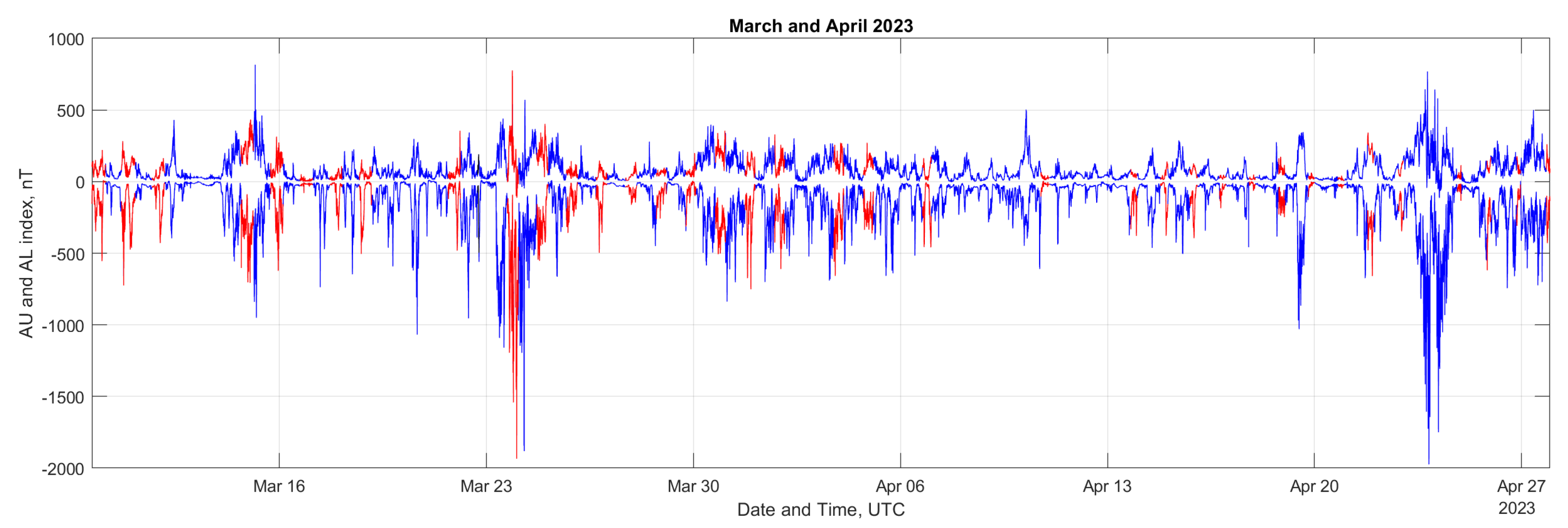

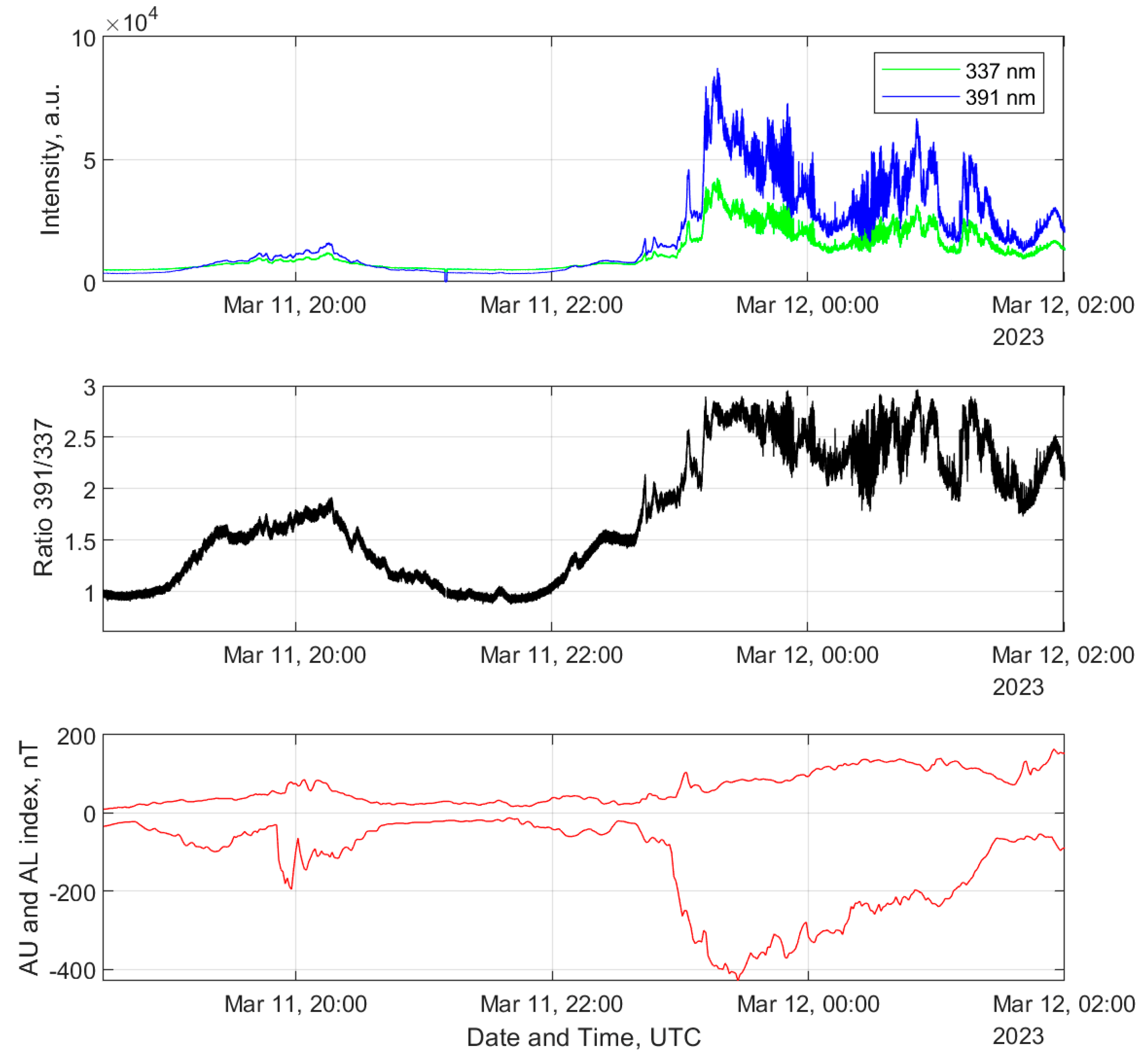
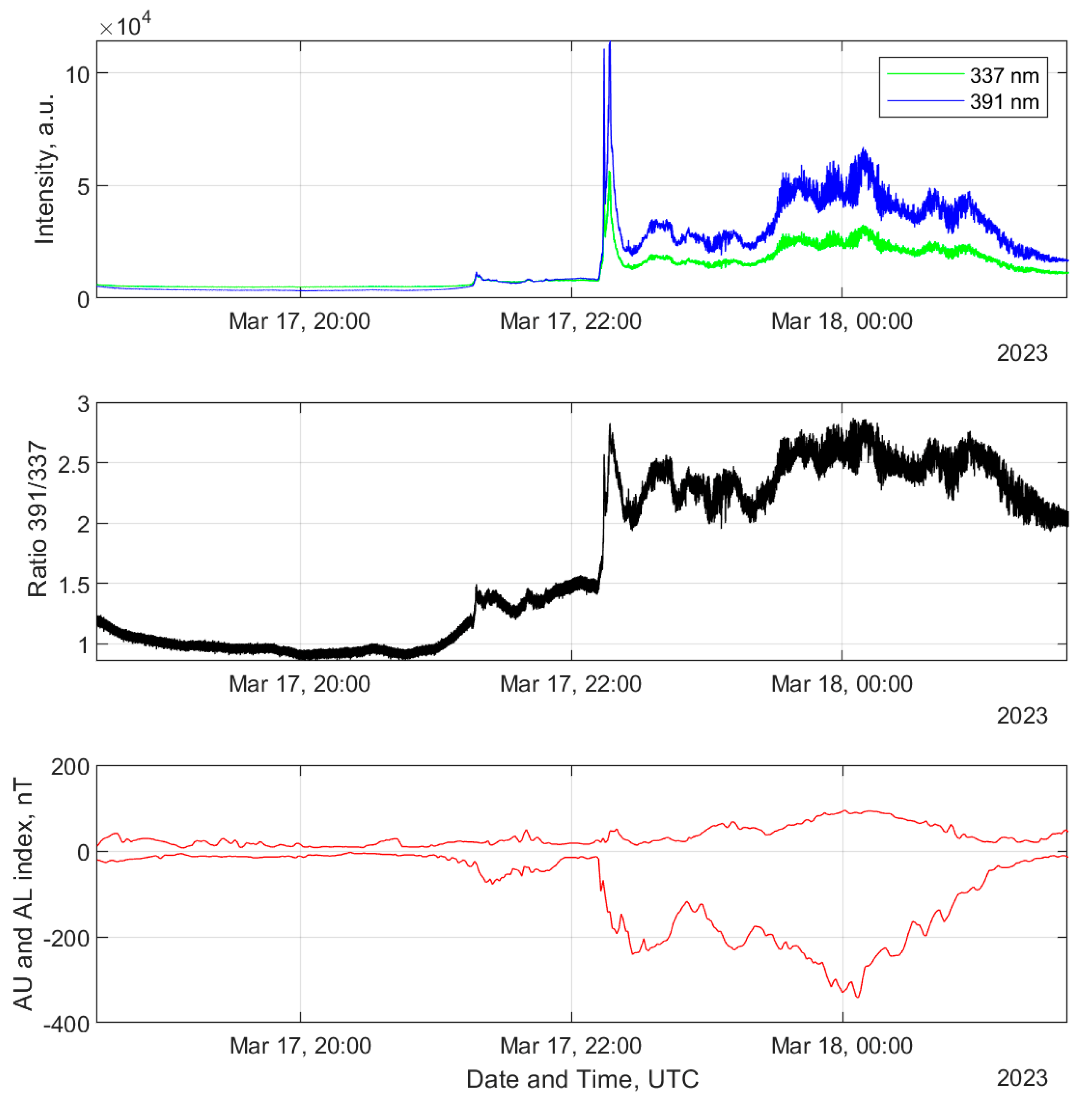
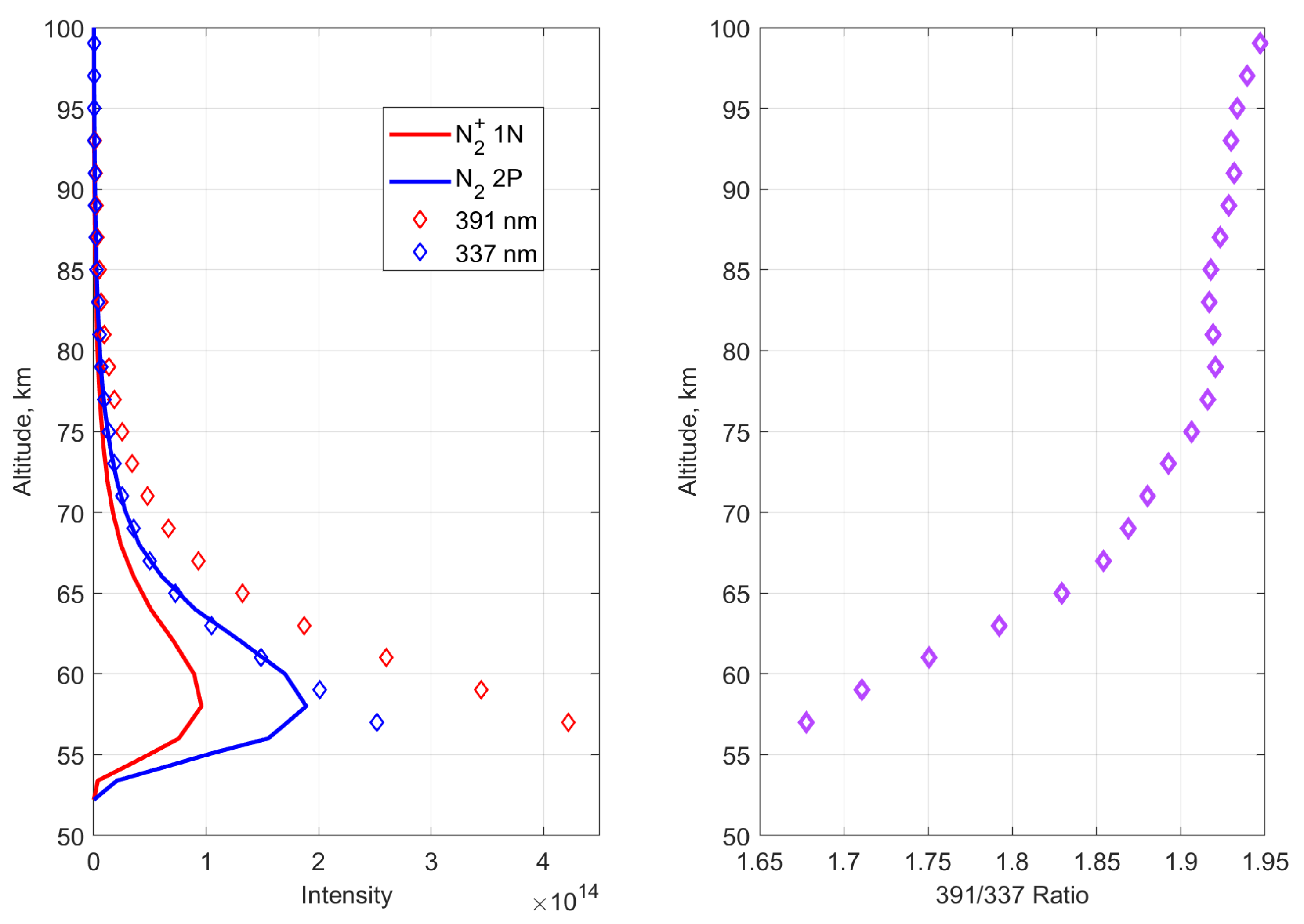
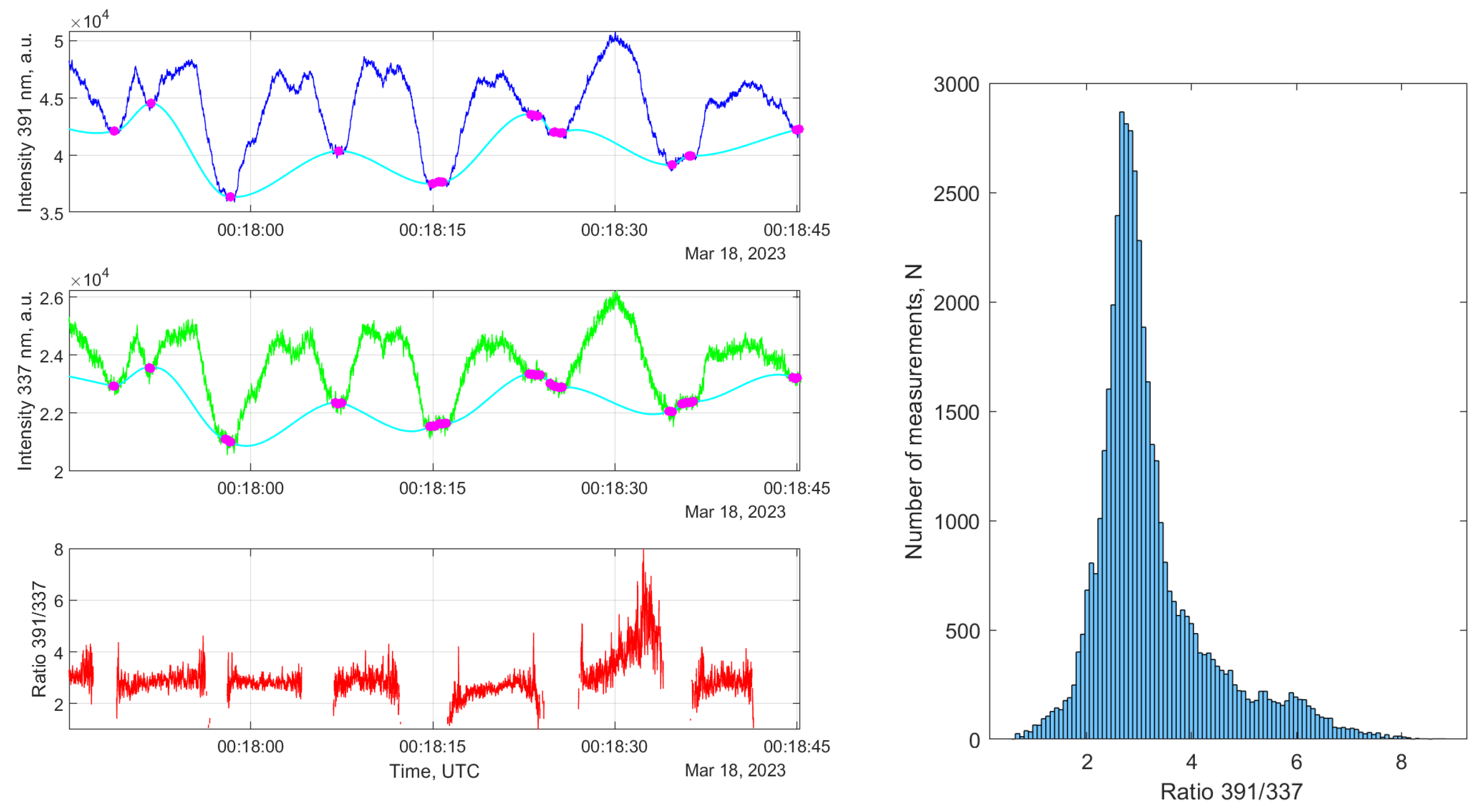
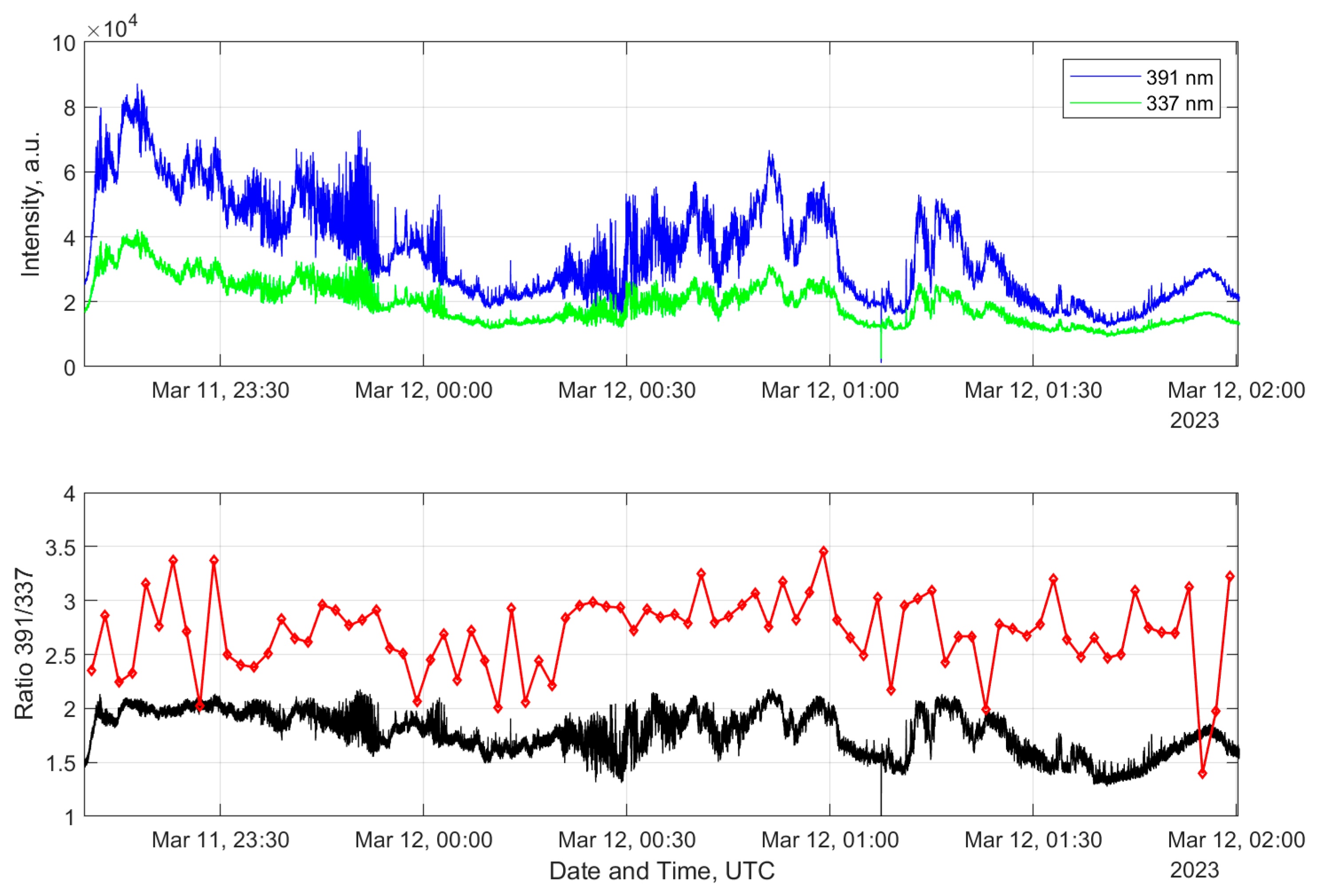
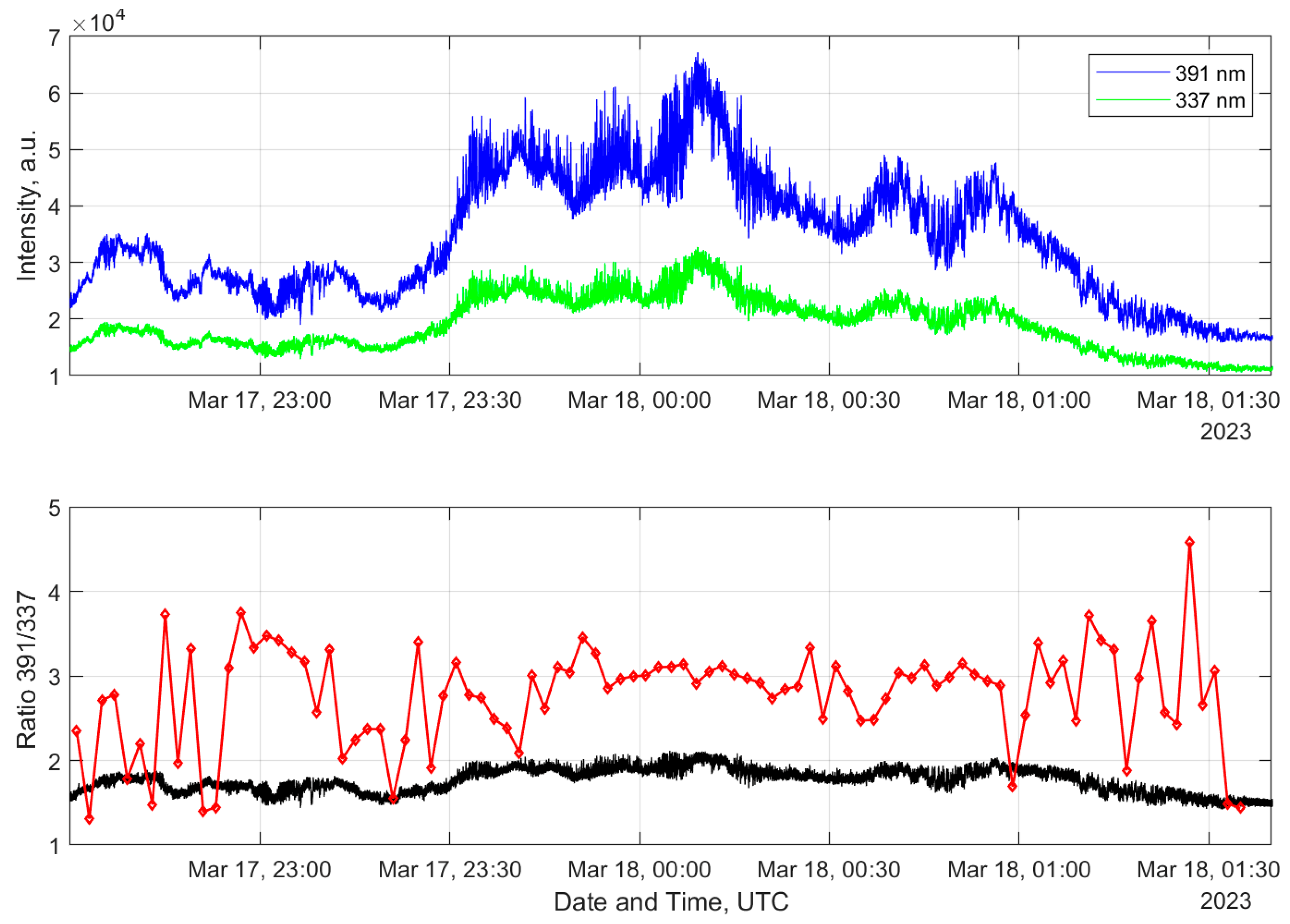
Disclaimer/Publisher’s Note: The statements, opinions and data contained in all publications are solely those of the individual author(s) and contributor(s) and not of MDPI and/or the editor(s). MDPI and/or the editor(s) disclaim responsibility for any injury to people or property resulting from any ideas, methods, instructions or products referred to in the content. |
© 2023 by the authors. Licensee MDPI, Basel, Switzerland. This article is an open access article distributed under the terms and conditions of the Creative Commons Attribution (CC BY) license (https://creativecommons.org/licenses/by/4.0/).
Share and Cite
Klimov, P.; Nikolaeva, V.; Belov, A.; Kozelov, B.; Murashov, A.; Roldugin, A.; Sharakin, S. Variations in Pulsating Aurora Emission in 337 nm and 391 nm Nitrogen Spectral Lines during Geomagnetic Substorms. Universe 2023, 9, 441. https://doi.org/10.3390/universe9100441
Klimov P, Nikolaeva V, Belov A, Kozelov B, Murashov A, Roldugin A, Sharakin S. Variations in Pulsating Aurora Emission in 337 nm and 391 nm Nitrogen Spectral Lines during Geomagnetic Substorms. Universe. 2023; 9(10):441. https://doi.org/10.3390/universe9100441
Chicago/Turabian StyleKlimov, Pavel, Vera Nikolaeva, Alexander Belov, Boris Kozelov, Alexei Murashov, Alexei Roldugin, and Sergei Sharakin. 2023. "Variations in Pulsating Aurora Emission in 337 nm and 391 nm Nitrogen Spectral Lines during Geomagnetic Substorms" Universe 9, no. 10: 441. https://doi.org/10.3390/universe9100441
APA StyleKlimov, P., Nikolaeva, V., Belov, A., Kozelov, B., Murashov, A., Roldugin, A., & Sharakin, S. (2023). Variations in Pulsating Aurora Emission in 337 nm and 391 nm Nitrogen Spectral Lines during Geomagnetic Substorms. Universe, 9(10), 441. https://doi.org/10.3390/universe9100441








